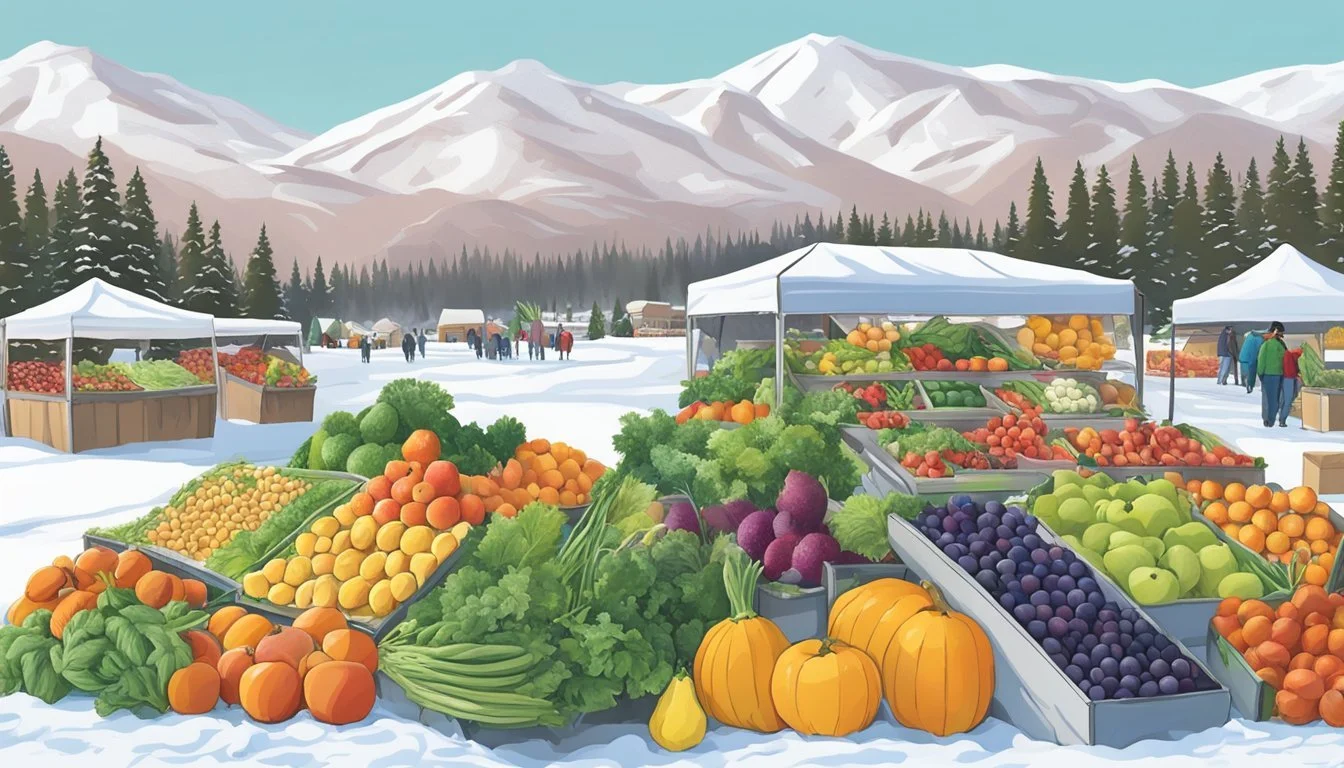Utah Seasonal Fruit & Vegetables in January
Your Essential Guide to Winter Produce
This Article is Part of our Utah Seasonal Fruit & Veg Calendar
In the frosty month of January, Utah offers a unique array of seasonal produce that not only endures the chilly weather but also provides fresh flavors and nutritional benefits. Amidst the snow-draped landscapes, local farmers and greenhouses manage to cultivate a variety of fruits (What wine goes well with fruit?) and vegetables that are specifically suited to the cold climate. The limited but robust selection of January harvests in Utah include root vegetables and hearty greens, which are prominent in local markets and are utilized in seasonal dishes.
Root vegetables such as carrots (how long do carrots last?)and celeriac can be found during this time, offering a sweet and earthy taste that is ideal for warming soups and stews. Cruciferous vegetables, including broccoli and cauliflower (how long does cauliflower last?), also remain in season. These versatile vegetables are packed with vitamins and can be enjoyed both raw and cooked, providing a nutritious addition to the winter diet.
Despite the limited fruit selection during this time, Utah's markets occasionally feature storages from late-harvested apples (how long do apples last?) and pears left over from autumn's bounty. They retain their freshness and offer a sweet contrast to the more savory winter vegetables. These fruits, along with the available winter vegetables, form the backbone of January's seasonal produce in Utah, allowing residents to enjoy locally-sourced and nutrient-rich produce even in the heart of winter.
Seasonal Eating Benefits
Seasonal eating refers to consuming fruits and vegetables at the time of year when they are naturally ripe and harvested. In Utah, eating seasonally in January offers several advantages. Firstly, freshness is a key benefit, as locally sourced produce doesn't require long-distance transportation, which can diminish taste and quality.
Fruits and vegetables harvested during their appropriate seasons also tend to be more nutrient-dense. For instance, winter seasonal foods may offer higher levels of vitamins C and K, crucial for maintaining a healthy immune system during colder months.
Vitamin C: found in citrus fruits – boosts immunity.
Vitamin K: present in leafy greens – aids in blood clotting and bone health.
Moreover, seasonal foods such as kale, apples, and root vegetables like carrots and beets (how long do beets last?), often have a rich flavor profile and are more economical. These economic benefits extend to both consumers and local farmers, fostering community and supporting local economies.
Season Benefits Winter Higher nutrients, better taste
By choosing seasonal fruits and vegetables, consumers support sustainable practices as well. It typically requires less energy and resources to grow and transport food within its natural growing season, thus reducing environmental impact.
Seasonal eating is not just a choice but a lifestyle that maximizes the benefits of nature's offerings. In January and throughout the winter, the practice of including seasonal produce in one's diet can be a wholesome, flavorful journey through the unique palate of seasonal bounty.
Winter Harvesting in Utah
During the winter months, the agricultural focus in Utah shifts to crops that are resilient to the cold weather. Farmers harvest a variety of produce that can tolerate or even thrive in Utah's chillier temperatures. The winter harvest typically includes storage crops and those grown in protected environments, such as hothouses.
Storage Crops:
Many of the fruits and vegetables that were harvested in the late summer and fall are stored and continue to be available through the winter. These storage crops include:
Apples: Stored from fall harvest
Beets: July through October (available from storage)
Carrots: Similar to beets, harvested before the frost and stored
Hothouse Crops:
Producers utilize controlled environments to grow certain crops year-round. Hothouses offer a stable climate to counter the harsh outdoor conditions. This allows for the production of:
Arugula: A leafy green whose prime season is spring and fall, yet it's available from hothouses in winter.
Herbs: Various herbs are cultivated in indoor settings
Utah's winter is marked by snow-covered fields and a crisp atmosphere, imposing challenges on the growing season. Yet, farmers adapt to these conditions, employing strategies such as cold storage and hothouse production to provide fresh produce. Despite the frosty weather, Utah continues to yield fresh, locally-grown vegetables through the innovative use of agricultural technologies.
Common Winter Fruits in Utah
In Utah, winter does not halt the availability of fresh fruits. Residents and visitors can enjoy a selection of produce typically associated with colder months. Among the prominent fruits are apples and pears, which, having been harvested in the late summer and fall, remain storage-stable and continue to be distributed well into the winter.
Apples come in various varieties, with some being more suited to the winter storage such as the Fuji, Gala, and Granny Smith. These are known for their crisp texture and versatility, being utilized in everything from fresh snacks to baked desserts.
Pears, much like apples, are a winter-friendly fruit. With varieties like the Bosc and D’Anjou, pears provide a sweet and sometimes slightly spiced flavor, perfect for both raw consumption and culinary use in dishes like poached pears or pear tarts.
Utah’s winter months also offer a range of citrus fruits, which are usually at their peak during this season. Although not typically grown in the colder Utah climate, citrus fruits such as oranges, grapefruits, and lemons are often available in grocery stores and markets, sourced from warmer regions.
In summary, Utah’s winter fruit assortment mainly centers on apples and pears, known for their longevity and winter suitability, along with citrus fruits that add a burst of freshness to the colder days.
Apples: Fuji, Gala, Granny Smith
Pears: Bosc, D’Anjou
Citrus Fruits: Oranges, Grapefruits, Lemons
This selection ensures that even during the cooler winter months, the residents of Utah can enjoy a variety of fresh, flavorful fruits.
Utah's Seasonal Winter Vegetables
In January, the cold Utah climate narrows the variety of locally available produce, yet certain robust vegetables thrive despite the chill. Utahns can find an assortment of hearty vegetables, which not only withstand winter's harshness but often become sweeter as they endure the frost.
Root Vegetables:
These include staples such as carrots and beets. They are known to have enhanced natural sugars after a frost, adding a richer flavor to winter dishes. Carrots, aside from being a versatile ingredient, provide significant amounts of vitamin A, while beets are a good source of fiber and vitamin C.
Carrots: A rich source of beta-carotene and fiber.
Beets: Noted for their earthy sweetness and vitamins.
Brassicas:
This family of vegetables remains undeterred by the cold, with kale, broccoli, and cauliflower headlining. These vegetables are not only nutrient-dense but also integrate well into a multitude of recipes.
Kale: Loaded with vitamins A, K, and C, it is ideal for salads and smoothies.
Broccoli: Rich in vitamins C and K, perfect for steaming or roasting.
Cauliflower: A versatile vegetable that can be mashed, roasted, or used as a low-carb substitute.
Alliums and Tubers:
Leeks, with their mild, onion-like taste, and potatoes, with their comforting starchiness, are excellent for soups and hearty stews.
Leeks: Offer a subtler, sweeter flavor than onions.
Potatoes: A diverse root vegetable enjoyed in many forms.
Cabbages and Squashes:
Cabbage, squash, and Brussels sprouts (how long do brussels sprouts last?) stand as winter's enduring edibles. Each has its distinctive taste and texture, suitable for both raw and cooked applications.
Cabbage: Great in slaws or fermented as sauerkraut.
Squash: Butternut and other varieties are sweet and filling.
Brussels Sprouts: When roasted, they take on a nutty, savory flavor.
Unique Offerings:
Some less common winter vegetables like turnips can also be found in Utah this time of year, offering variety to the winter palate.
Turnips: Offer a peppery flavor that can complement many dishes.
These vegetables tend to be available at winter farmers' markets or grocery stores with an emphasis on local sourcing. Utah's winter promotes a harvest that is not just about survival but about enjoying the season's unique flavors.
Citrus Fruit Spotlight
Utah's January climate might be chilly, but its produce selection offers some delightful warmth. The citrus fruits available this month are packed with vitamins, intensely flavorous, and extremely versatile in culinary uses.
Grapefruit Profile
The grapefruit, thriving in Utah's winter greenhouses, stands out with its bittersweet flavor. Grapefruits in January are brimming with vitamin C, a necessary nutrient for fighting winter colds. The local varieties, often pink or red inside, are juicier and have a deep aromatic quality.
Lemon Varieties
Lemons are another citrus fruit that Utahns enjoy in January. Varieties range from the classic Eureka and Lisbon lemons, known for their tangy zest and juice, to the Meyer lemon, a sweeter and less acidic option which is more akin to an orange in flavor and ideal for desserts.
Orange Selections
January also brings an abundance of oranges to Utah's produce scene. Choices include the Navel orange, which is seedless and ideal for snacking, and the Valencia orange, which is sought after for juicing due to its excellent balance of sweetness and tartness. These oranges are not just flavorful but also offer a boost of vitamin C during the cold season.
Root Vegetables and Hardiness
In January, Utah's strong winter embraces soil and sky, constraining most agricultural activities. Despite this, some robust root vegetables thrive, owing to their hardiness—they can withstand the cold and are often harvested during or at the end of winter.
Root vegetables ideal for Utah's climate include:
Sweet Potatoes: They are usually harvested before the frost of winter, but stores well during the cold months.
Celery Root (Celeriac): While not typically harvested in winter, it stores well and can be utilized in January dishes.
Parsnips: This hardy vegetable can endure freezing temperatures, and some Utah gardeners leave them in the ground to sweeten with the frost.
Turnips: They are another root vegetable capable of surviving winter's chill, often harvested in late autumn yet remaining edible throughout winter.
Hardiness in vegetables refers to their capability to withstand cold weather. The mentioned root vegetables possess this trait, allowing them to be stored and used throughout the colder months:
Root Vegetable Hardiness Qualities Storage Tips Sweet Potatoes Sensitive; best harvested pre-frost Store in a cool, dark place Celery Root Moderate; survives light frosts Keep refrigerated; wrap to retain moisture Parsnips High; improves taste post-frost Can be left in ground or stored cool and humid Turnips High; very freeze-tolerant Store in a cold, moist environment
These vegetables provide a nutritious option during a time when fresh produce is less available, offering both sustenance and variety to the winter diet. Gardeners and consumers should consider the hardiness of these root vegetables when seeking ingredients for hearty meals.
Preparing and Cooking Seasonal Produce
When cooking with Utah's seasonal fruits and vegetables in January, one can embrace the robust flavors and nutrients of winter produce. Utilizing these ingredients in salads, hot dishes, and as snacks not only ensures freshness but also maximizes taste and health benefits.
Salads and Dressings
Salads with January produce become hearty meals or refreshing sides. Incorporating root vegetables like beets and winter greens can enhance the nutritional value of any salad. One might create dressings using apple cider vinegar for a tart kick or a honey-Dijon blend for a sweet and tangy flavor profile.
Recipe Suggestion: Beet and Carrot Salad
Dressing: Sherry vinegar, olive oil, mustard (how long does mustard last?), honey, salt, and pepper.
Stews and Hot Dishes
Stews permit a symphony of flavors to develop, making them a winter staple. Utilizing seasonal vegetables like carrots and cabbages, cooks can build depth in their stews. For a more complex taste, one could add herbs such as thyme or rosemary.
Stew Components:
Base: Broth (vegetable, chicken, beef)
Vegetables: Carrots, onions, parsnips, potatoes
Herbs: Bay leaf, thyme
Healthy Snacking
Snacks made from seasonal produce provide essential nutrients without compromising on taste. One might opt for roasted cauliflower or carrot sticks seasoned with herbs and spices as a savory option. Alternatively, homemade salsa using stored or greenhouse-grown tomatoes provides a fresh taste even in the colder months.
Snack Ideas:
Roasted Vegetables: Lightly tossed in olive oil, sea salt (how long does sea salt last?), and cracked black pepper.
Salsa: Fresh or canned tomatoes (how long does canned tomatoes last?), onion, cilantro, lime juice, salt, and pepper.
Utah Farmers Markets in Winter
During the cold months, Utah farmers markets adapt to the season, offering a variety of produce despite the chill. They become a hub for accessing winter-harvested vegetables and fruits that have been stored to last beyond their typical growing season. Root vegetables and hardy greens often feature predominantly, along with preserved goods.
Salt Lake City Winter Farmers Market serves as a prime example. Located at The Gateway, it operates every Saturday from 10:00 a.m. to 2:00 p.m. through mid-April, providing locals with a range of seasonal goods. Although fresh fruit off the tree is scarce, storage crops like apples continue to be available.
Produce Typically Available:
Fruits: Stored apples, dried figs (how long do dried figs last?), preserved fruits
Vegetables: Beets, winter squash, potatoes, onions
Farmers also offer products like honey, jams, and baked goods, highlighting the versatility of Utah's agricultural bounty. Patrons can find comfort in the consistent quality of the produce, with many items grown in high tunnels or hothouses to extend their availability into the winter months.
While some markets may close for the holidays, they often reopen promptly, allowing residents to resume their shopping. The dedication of Utah's farmers ensures that even as the temperature falls, access to locally-grown produce remains within reach.
Conclusion
In January, Utah's winter clime significantly narrows the range of fresh, local produce available. However, residents and visitors alike can still enjoy a limited variety of hearty winter crops. They predominantly consist of stored items like apples that were picked in the fall and root vegetables that can withstand the colder temperatures.
Seasonal Produce Available:
Apples: Typically harvested in late summer through fall, with cold storage extending their availability.
Root Vegetables: Such as beets and carrots, are often harvested in late fall and can be stored effectively.
Cruciferous Vegetables: Broccoli and cauliflower are examples that may be found, depending on the local growing practices and hothouse availability.
Utah gardeners often employ season extension techniques like hothouses to expand the types of produce that can be grown during the winter months. This means that greens like arugula can sometimes be found even when the outdoor landscape is dormant.
Purchasing produce that is in season not only supports local agriculture but often provides a more flavorful addition to meals. While the variety may be limited during Utah's winter months, the available winter produce can still offer vital nutrients and add a fresh component to hearty winter dishes.











